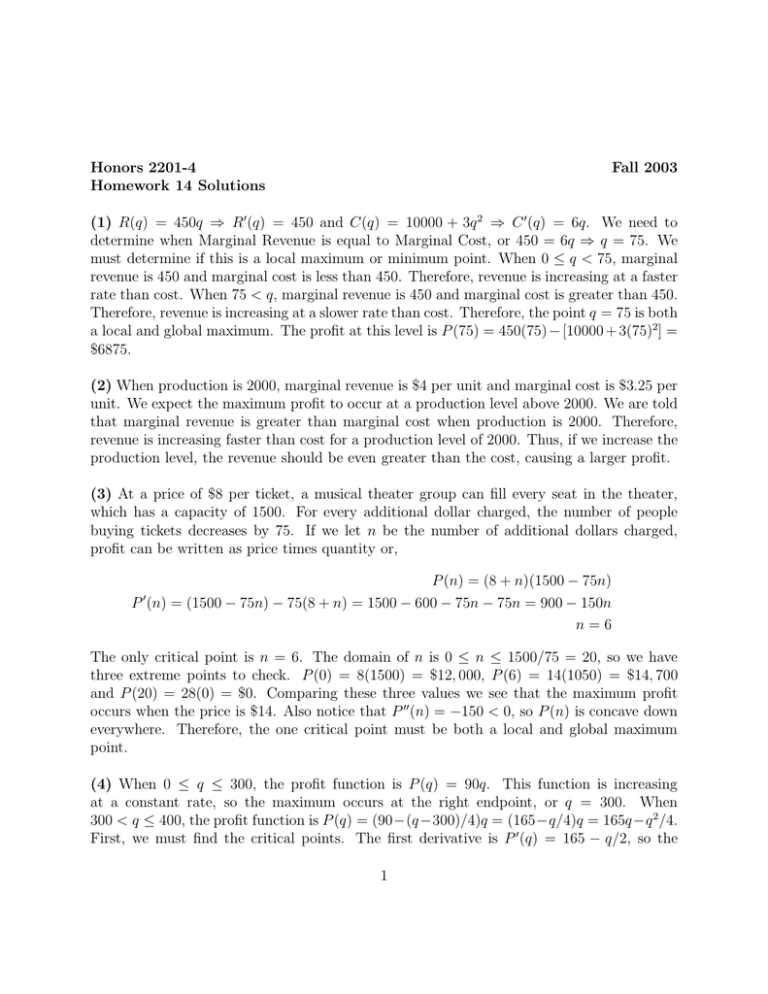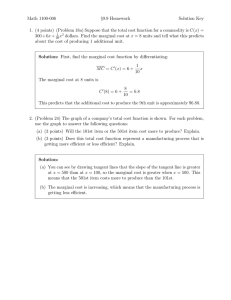Honors 2201-4 Fall 2003 Homework 14 Solutions (1) R(q) = 450q ⇒ R
advertisement

Honors 2201-4 Homework 14 Solutions Fall 2003 (1) R(q) = 450q ⇒ R0 (q) = 450 and C(q) = 10000 + 3q 2 ⇒ C 0 (q) = 6q. We need to determine when Marginal Revenue is equal to Marginal Cost, or 450 = 6q ⇒ q = 75. We must determine if this is a local maximum or minimum point. When 0 ≤ q < 75, marginal revenue is 450 and marginal cost is less than 450. Therefore, revenue is increasing at a faster rate than cost. When 75 < q, marginal revenue is 450 and marginal cost is greater than 450. Therefore, revenue is increasing at a slower rate than cost. Therefore, the point q = 75 is both a local and global maximum. The profit at this level is P (75) = 450(75) − [10000 + 3(75)2] = $6875. (2) When production is 2000, marginal revenue is $4 per unit and marginal cost is $3.25 per unit. We expect the maximum profit to occur at a production level above 2000. We are told that marginal revenue is greater than marginal cost when production is 2000. Therefore, revenue is increasing faster than cost for a production level of 2000. Thus, if we increase the production level, the revenue should be even greater than the cost, causing a larger profit. (3) At a price of $8 per ticket, a musical theater group can fill every seat in the theater, which has a capacity of 1500. For every additional dollar charged, the number of people buying tickets decreases by 75. If we let n be the number of additional dollars charged, profit can be written as price times quantity or, P (n) = (8 + n)(1500 − 75n) P (n) = (1500 − 75n) − 75(8 + n) = 1500 − 600 − 75n − 75n = 900 − 150n n=6 0 The only critical point is n = 6. The domain of n is 0 ≤ n ≤ 1500/75 = 20, so we have three extreme points to check. P (0) = 8(1500) = $12, 000, P (6) = 14(1050) = $14, 700 and P (20) = 28(0) = $0. Comparing these three values we see that the maximum profit occurs when the price is $14. Also notice that P 00 (n) = −150 < 0, so P (n) is concave down everywhere. Therefore, the one critical point must be both a local and global maximum point. (4) When 0 ≤ q ≤ 300, the profit function is P (q) = 90q. This function is increasing at a constant rate, so the maximum occurs at the right endpoint, or q = 300. When 300 < q ≤ 400, the profit function is P (q) = (90−(q−300)/4)q = (165−q/4)q = 165q−q 2 /4. First, we must find the critical points. The first derivative is P 0 (q) = 165 − q/2, so the 1 Problem 5 Dollar Amount 300 R(q) 200 C(q) 100 o o 0 0 100 200 300 Quantity (q) critical point is 330. The first derivative is positive when 300 < q < 330 and negative when 330 < q ≤ 400, so q = 330 is a local maximum. To determine the global maximum we compare the profits at all local extreme points. P (0) = $0, P (300) = 90(300) = $27, 000, P (330) = 330(82.50) = $27, 225 and P (400) = 400(65) = $26, 000. The maximum profit occurs when q = 330. (5) Profit is positive when the cost is less than the revenue. This happens on the approximate interval 77 < q < 180. The profit is negative when cost is greater than revenue, or 0 ≤ q < 77, and 180 < q. The only critical point occurs when the marginal cost is equal to the marginal revenue. To find this point we must determine when the cost function has a tangent line with the same slope as the revenue function. From the line drawn on the figure, we see that this occurs when q ≈ 133. On the interval 0 < q < 133 the marginal cost is less than the marginal revenue (the marginal cost is actually negative for much of this interval), so revenue is increasing faster than cost. On the interval 133 < q the marginal cost is greater than the marginal revenue, so cost is increasing faster than revenue. Therefore, the point q = 133 is a maximum. (6) Average cost is the slope of the line from the origin to the point (100, C(100)) = (100, 150). Marginal cost is the slope of the line tangent to the cost curve. Therefore, A(100) = 150/100 = 1.5 and MC(100) = 0. When q = 100 the average cost is greater than the marginal cost, so increasing production will decrease the average cost. Average cost is minimized when the marginal cost is equal to the average cost, or the slope of the line from the origin to the point is the same as the slope of the line tangent to the cost function at that point. This occurs when q ≈ 160. 2 Problem 6 Dollar Amount 300 C(q) 200 100 0 0 100 200 300 Quantity (q) (7) C(q) = 2500 + 12q ⇒ C 0 (q) = 12. The marginal cost of producing both the 100th and 1000th items is $12. The average costs at these q values are A(100) = (2500+1200)/100 = $37 and A(1000) = (2500 + 12000)/1000 = $14.50. As q increases, the average cost decreases to $12 per unit. (8) We are told that the marginal cost is $10 and the average cost is $15. Since the marginal cost is less than the average cost, the average cost should decrease as production is increased above q = 2000. (9) MC = C 0 (1200) = 3, R(q) = 20q and MR = R0 (q) = 20. Also, A(1200) = 2 so C(1200) = 2400. Therefore, R(1200) = 24000 and profit is P (1200) = R(1200) − C(1200) = 20(1200) − 2400 = 24000 − 2400 = $21600. The firm is making money. We see that the marginal cost is greater than the average cost, so increasing production will increase the average cost. However, revenue is not constant. Instead, it increases at a rate of $20 per pair of slippers. Cost is only increasing at a rate of $3 per pair of slippers. We see from this that MR >> MC, so increasing production will increase the overall profit. Production should be increased. (10) 3% price increase and E = 2 ⇒ 6% decrease in demand 2= 100 3 ∆q ∆q 2(3) ⇒ · =− = −.06 q q 100 3 3% price increase and E = 0.5 ⇒ 1.5% decrease in demand ∆q 3/2 1 100 ∆q ⇒ = · =− = −.015 2 3 q q 100 (11a) a high definition television set - elastic, luxury item (11b) a particular brand of laundry detergent - elastic, other options (11c) local telephone service - inelastic, necessity (12) If p = 2, q = 5000 − 40 = 4960, so 4960lbs will be sold. dq = −20p dp p dq 2 1 E= · = · (−20)(2) = << 1 q dp 4960 62 The demand when p = 2 is inelastic (E ≈ .016), so people seem to buy yams no matter what the price is. The equation for revenue is R(p) = p(5000 − 10p2 ) = 5000p − 10p3 . The revenue when p = 2 is R(2) = 2(4960) q = $9, 920. MR = R0 (p) = 5000 − 30p2 . The revenue function has a critical point when p = 500/3 ≈ 12.91. This is the only critical point in the q q interval 0 ≤ p. When 0 ≤ p < 500/3, the marginal revenue is positive. When 500/3 < p, the marginal revenue is negative. Therefore, the maximum revenue occurs when p ≈ $12.91. At this price, q = 5000 − 10(12.91)2 = 3333.319. An integer number of yams are sold, so we assume that 3333 are sold. The total revenue is R(12.91) = (12.91)(3333) = $43, 029.03. E= 12.91 3333 · (−20)(12.91) 4 = 1.000108611 ≈ 1








